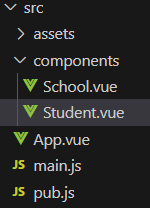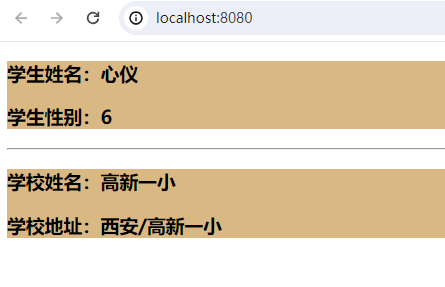mixin混入:可以理解为是代码的一种重构复用
一个混入对象可以包含任意组件选项(如data、methods、mounted等等)。当组件使用混入对象时,所有混入对象的选项将被“混合”进入该组件本身的选项。
示例一:局部混合示例
局部混入就是在单独的vue组件中引入了mixin混入对象

Student.vue
1 2 3 4 5 6 7 8 9 10 11 12 13 14 15 16 17 18 19 20 21 22 23 24 25 26 27 28 29 30 31 32 33 34 35 36 | <!-- 组件的结构 --><template> <div class="demo"> <h3 @click="showName">学生姓名:{{name}}</h3> <h3>学生性别:{{ stuAge }}</h3> </div></template><!-- 组件交互相关的代码(数据、方法等) --><script>// eslint-disable-next-line no-unused-varsimport { mixin } from '../mixin.js' //引入混合export default ({ // eslint-disable-next-line vue/multi-word-component-names name: 'Student', data () { return { msg: '我正在学习 Vue', name: '心仪', stuAge: 6 } }, // methods: { // showName () { // alert(this.name) // } // }})</script><!-- 组件的样式 --><style>.demo { background-color: burlywood;}</style> |
School.vue
1 2 3 4 5 6 7 8 9 10 11 12 13 14 15 16 17 18 19 20 21 22 23 24 25 26 27 28 29 30 31 32 33 34 35 36 | <!-- 组件的结构 --><template> <div class="demo"> <h3 @click="showName">学校姓名:{{name}}</h3> <h3>学校地址:{{ schoolAddress }}</h3> </div></template><!-- 组件交互相关的代码(数据、方法等) --><script>// eslint-disable-next-line no-unused-varsimport { mixin } from '../mixin.js' //引入混合export default ({ // eslint-disable-next-line vue/multi-word-component-names name: 'Student', data () { return { msg: '我正在学习 Vue', name: '高新一小', schoolAddress: '西安/高新一小' } }, // methods: { // showName () { // alert(this.name) // } // }})</script><!-- 组件的样式 --><style>.demo { background-color: burlywood;}</style> |
重构的复用代码:pub.js
1 2 3 4 5 6 7 8 | // eslint-disable-next-line no-unused-varsexport const mixin = { methods: { showName () { alert(this.name) } }} |
App.vue
1 2 3 4 5 6 7 8 9 10 11 12 13 14 15 16 17 18 19 20 21 22 23 24 25 26 | <template> <div> <!-- <img src="./assets/logo.png"> --> <Student></Student> <hr> <School></School> </div></template><script>// 引入组件import Student from './components/Student.vue';import School from './components/School.vue';export default { name: 'App', components: { Student, School },}</script><style></style> |
main.js
1 2 3 4 5 6 7 8 9 10 11 12 13 | /* 该文件是整个项目的入口文件 */// 引入Vueimport { createApp } from 'vue'// 引入App组件,其是所有组件的父组件import App from './App.vue'// new Vue({// render: h => h(App),// }).$mount('#app')// 创建实例对象vm 并将App组件放入容器中——等价于 上面代码createApp(App).mount('#app') |

示例二:全局混合示例
混入也可以进行全局注册(慎用)。一旦使用全局混入,它将影响每一个之后创建的 Vue 实例。使用恰当时,这可以用来为自定义选项注入处理逻辑。
全局混入我们只需要把mixin.js引入到main.js中,然后将mixin放入到Vue.mixin()方法中即可;
第一步:
注释掉个个组件中的独立引用:类似// import { mixin } from '../mixin.js' //引入混合
第二步:main.js引入混合
1 2 3 4 5 6 7 8 9 10 11 12 13 | // 引入Vueimport { createApp } from 'vue'// 引入App组件,其是所有组件的父组件import App from './App.vue'import { mixin } from './mixin.js';createApp(App).mount('#app').mixin(mixin)// new Vue({// render: h => h(App),// }).$mount('#app')// 创建实例对象vm 并将App组件放入容器中——等价于 上面代码createApp(App).mount('#app') |
总结:
功能:可以把多个组件共用的配置提取成一个混入对象
使用方式:
第一步:定义混合,例如
1 2 3 4 5 6 7 | export const mixin = { methods: { showName () { alert(this.name) } }} |
第二步:使用混合,例如
局部引用: mixins:['xxx'] // import { mixin } from '../mixin.js' //引入混合
全局引用:Vue.mixin(xxx)
1 2 | import { mixin } from './mixin.js';createApp(App).mount('#app').mixin(mixin) |
博客内容主要用于日常学习记录,内容比较随意,如有问题,还需谅解!!!






【推荐】国内首个AI IDE,深度理解中文开发场景,立即下载体验Trae
【推荐】编程新体验,更懂你的AI,立即体验豆包MarsCode编程助手
【推荐】抖音旗下AI助手豆包,你的智能百科全书,全免费不限次数
【推荐】轻量又高性能的 SSH 工具 IShell:AI 加持,快人一步
· 被坑几百块钱后,我竟然真的恢复了删除的微信聊天记录!
· 【自荐】一款简洁、开源的在线白板工具 Drawnix
· 没有Manus邀请码?试试免邀请码的MGX或者开源的OpenManus吧
· 园子的第一款AI主题卫衣上架——"HELLO! HOW CAN I ASSIST YOU TODAY
· 无需6万激活码!GitHub神秘组织3小时极速复刻Manus,手把手教你使用OpenManus搭建本